
Osteoarthritis is a chronic joint disease that develops as a result of a metabolic disorder. As a result, degenerative, dystrophic and destructive changes in cartilage tissue occur.
It occurs inconspicuously, but usually develops very quickly. A person begins to experience pain in the joints with movement, stiffness and reduced mobility, especially in the morning, while remaining "not normal". If discomfort occurs and pain periodically occurs with movement or when movement is difficult, it is very important to understand that this will not go away and without intervention the situation willonly got worse.
Symptoms of Arthritis
Osteoarthritis of large and medium joints seriously alters a person's lifestyle, worsens quality and imposes restrictions. The development of the disease is like an avalanche and the treatment is often accompanied by unbearable pain, and this is a clear sign of wear and tear in the joints.
Symptoms of osteoarthritis depend on how much the joint, cartilage, and nearby tissues are affected.
In the early stages, the joint disease can be identified quite accurately, the treatment in this case is little and does not require serious intervention as well as expensive drugs to treat the joint disease.
Types of joint diseases
Arthritis is classified according to several criteria. Depending on the degree of joint changes in the cartilage tissue, 4 stages of arthropathy are distinguished. Arthritis is also divided into primary and secondary. The cause of the development of primary arthropathy is age-related changes. Secondary arthropathy occurs as a result of trauma and joint diseases (eg, traumatic arthropathy or rheumatoid arthritis). The disease can also develop slowly over many years or lead to joint destruction in just a few years (advanced arthropathy).
There are alsoTypes of joint disease depending on the area affected:
- - arthritis of the knee joint - arthritis of the hip joint
- Cervical spondylosis - cervical spondylosis
- Spondylolisthesis - damage to the spine
- Osteoarthritis of the kneecap is a type of gonadal fibrosis in which the kneecap and part of the femur are damaged.
The extent of the disease is determined by the extent of the damage to the cartilage tissue.
Osteoarthritis grade 1 - cartilage tissue is slightly damaged, the patient does not feel discomfort;
Arthritis grade II - the appearance of osteoblasts, the reduction of the space between the cartilages, the appearance of situational pains with clumsy movements;
Grade III arthritis - cartilage tissue is destroyed in places and exposes bone tissue, space between cartilages is reduced, pain is frequent and severe;
Osteoarthritis grade IV - a significant part of cartilage tissue is destroyed up to 60%, there is no gap between the bones, the patient has constant, severe pain, the area above the joint has hyperthermia.
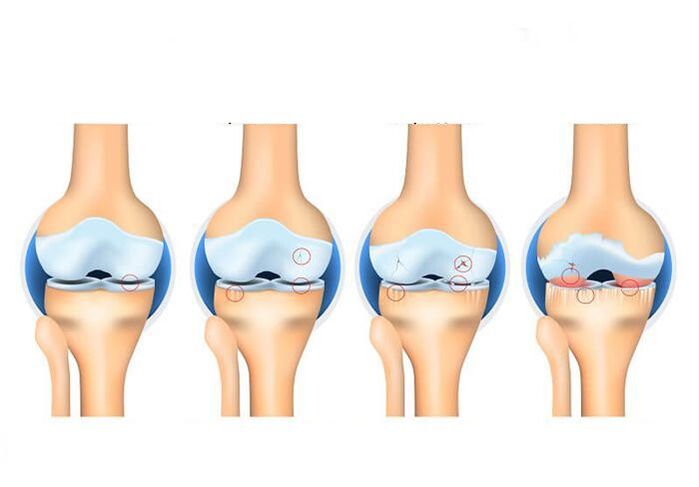
- Characteristic crackling on movement and slight background pain;
- Limited joint movement, discomfort with full physical activity;
- Blood pressure indicators "jump";
- Headache and dizziness;
- Convulsive syndrome and often muscle spasms;
- Joint deformation can be observed with the naked eye;
- Blisters, hyperthermia or redness of the skin over the affected joint;
- Violation of motor function.
Why does the disease appear?
Osteoarthritis can manifest itself in any part, but most patients usually turn their head when the knee or hip arthritis feels on its own. In the field of expertise, with a particular, specific load on the hand, osteoarthritis of the shoulder can be observed.
Lesions are different in men and women.The strong half often suffers from osteoarthritis of the temporomandibular joint, wrist, ankle and lumbar. Women complain more about the chest and cervical area, as well as the joints of the fingers and big toes.
The type of disease is determined by the location of the lesion. There are the following types:
- hip arthritis - coxarthrosis;
- rheumatism of the knee joint - gonarthrosis;
- damage to the kneecap and part of the femur - patellar arthritis (a type of inflammatory disease of the gonads);
- spinal diseases - dry joints of the vertebrae;
- cervical spine injury - cervical spondylosis.
The main reasons are:
- inflammatory process;
- Professional sports;
- overweight;
- professional non-standard loads, for example, squatting or kneeling;
- previous joint injury (post-traumatic);
- Hypothermia;
- heredity;
- age change.
Arthritis can present as a standalone disease or can be the result of an existing disease, so it's important to know a person's history.
Diagnosing dry joints
Arthritis is detected by X-ray. The X-ray image shows how deformed the joint is and how much the joint space has narrowed. An MRI or arthroscopy may also be necessary, but only in particularly complicated and unclear cases. Usually a joint X-ray is enough to diagnose the disease.
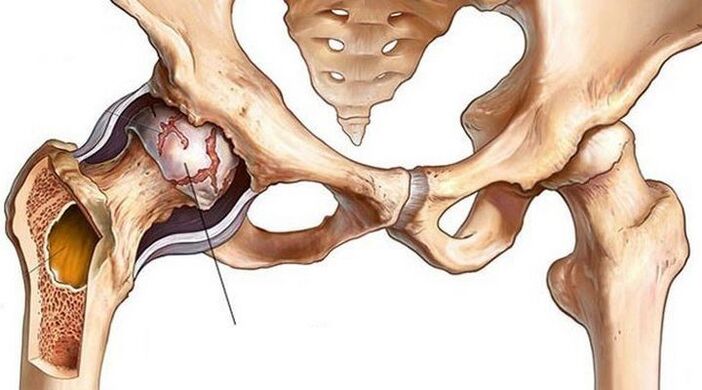
To understand the presence of the disease, its severity, as well as what disorders lead to the disease, a comprehensive diagnosis is made.
First, with helpX-rays in different projectionsget information about the extent of joint damage.
Tomography (magnetic resonance or computer) helpsexclude tumor processes.
Third, you needtake a testto understand whether arthropathy is an independent disease or a complication, as well as to determine a person's general condition.
The complexity of the studies is most informative and gives a clear idea of the degenerative-dystrophic changes and helps to choose the optimal treatment option.
Arthritis treatment
As discussed above, joint disease can develop due to many factors and a treatment plan is developed based on an understanding of the underlying causes and the appropriate selected rheumatic drugs.
Treatment should be developed individually, based on the results of the diagnosis. Be sure to take into account the person's condition, his existing diseases.
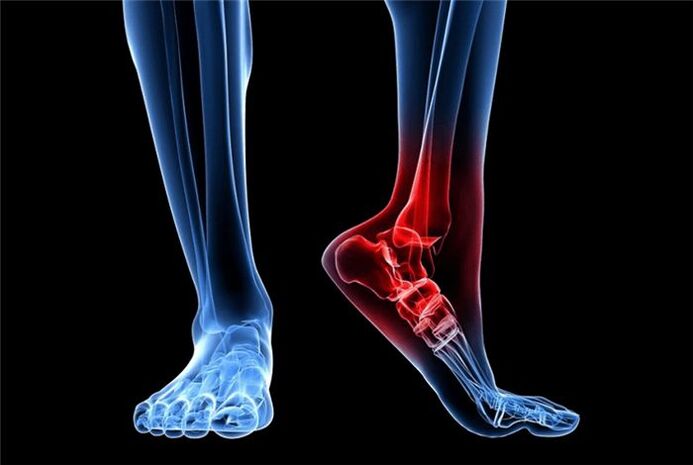
The recovery of joint surface and cartilage tissue is not rapid. Prescribed effective drugs have side effects. And taking the drug to get the desired results lasts up to 6 months, so it's important to protect your health as much as possible from side effects.
Medical treatment of joint disease
The main goal of this therapy is to eliminate the manifestations of joint disease. Medications to treat dry joints include:
- Non-steroidal anti-inflammatory drugs. With arthritis, a person experiences pain, the joints become inflamed. To eliminate unpleasant symptoms and stop inflammation, this group of drugs is prescribed.
- Inject hormones into the joint. Corticosteroids are most commonly used in the acute phase of joint disease.
- Chondroprotectors. The main task of these drugs is to stop the degenerative process in the cartilage tissue to prevent its further destruction.
- Intra-articular hyaluronic acid injection. Hyaluronic acid preparations are similar to synovial fluid, providing gentle and smooth free movements in the joints. With joint disease, synovial fluid is not secreted enough, so orthopedists often prescribe hyaluronic acid injections (injections into joints with arthritis).
- Biologic therapy for joint disease (PRP and cytokine therapy). A new innovative treatment for osteoarthritis, recently introduced but is becoming increasingly popular. This is the administration of a drug based on the patient's platelet-enriched plasma. Thanks to biological therapy, the blood supply to the joints is activated, the production of intra-articular fluid is activated, the cartilage tissue is supplied with nutrients.
Importance!Arthritis medications are effective in the early stages of the disease. In addition, experts also emphasize that drug treatment is not able to restore damaged joints, but it will help eliminate symptoms and slow the progression of joint disease.
Physiotherapy and other conservative treatments for joint disease
In the fight against dryness of the joints, physiotherapy is also used. Various procedures are prescribed (laser, photoelectric, electrophoresis, magnetic therapy, UVT) and exercise therapy to improve metabolism and blood circulation, strengthen muscles.
Plus, with joint disease, you just need to make a few adjustments to your lifestyle:
- Avoid overloading - it's important to evenly distribute activity and breaks so you don't overload your joints
- Take care of your diet and watch your weight - because being overweight only worsens joint problems, you need to review your diet and reduce your body weight
- Remember to be careful and avoid getting injured as much as possible
- Use additional support for movement - in the later stages of joint disease, independent movement becomes questionable, so you need to use a cane or crutches. For more comfortable walking, you can also use orthopedic insoles - they will reduce the load on the joints.
There are also many folk recipes that "will help beat arthritis. " However, home treatment for joint disease does not always work. Moreover, the use of all homemade lotions and ointments usually only causes allergic reactions and does not affect joint health.
Osteoarthritis surgery
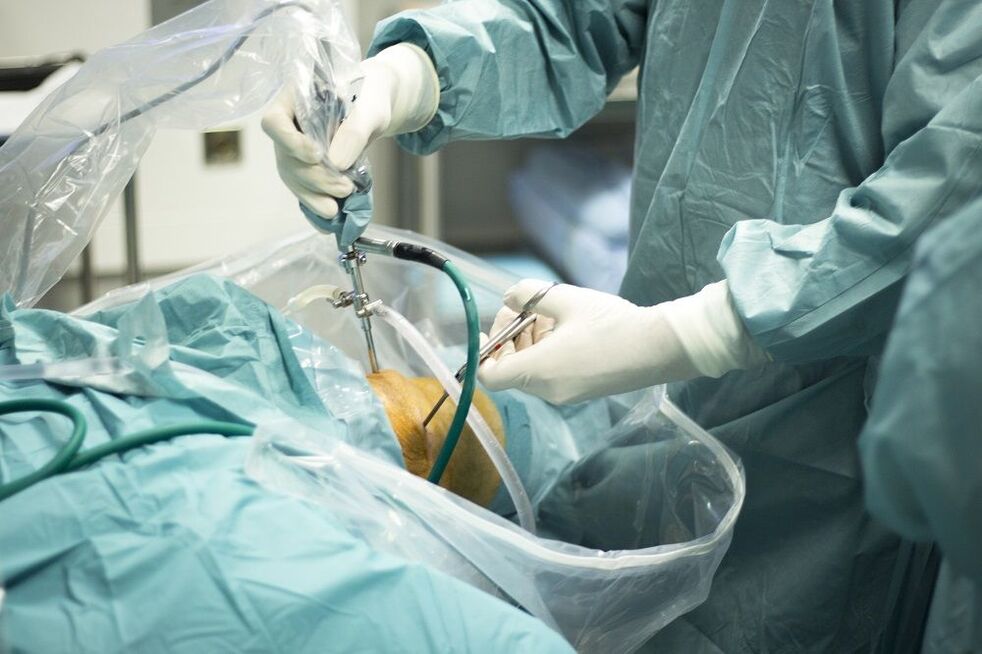
How to treat joints if all the above methods do not work? In this case, surgical treatment of osteoarthritis is prescribed. Depending on the degree of joint damage, the individual characteristics of each patient, the type of surgery is selected.
Arthroscopy is a minimally invasive method, an intra-articular operation through a number of microscopic holes in the joint. With arthritis, it is used as a temporary measure to "cleanse the joints": remove cartilage, bone cells that grow that interfere with free movement. Such treatment relieves pain in the joints, but is not a solution to the arthritis problem.
An osteotomy is an operation to align the axis of a joint. The fact is that with ankylosing spondylitis, as a rule, one part of the joint suffers more (it bears a large load). As a result of osteotomy, the load on the joint is redistributed. It should be noted that arthropathy is a progressive disease of the joints. So osteotomy is a way to delay further treatment, but not to avoid it.
Orthopedic surgery is an effective and in some cases the only way to treat fibromyalgia. The essence of the surgery is to remove a joint destroyed by the disease and implant an artificial organ in its place. Artificial joints are selected individually, suitable for each patient and fully supplement the function of the damaged joint after a period of rehabilitation.
Contraindications for dry joints
Things you need to pay attention to when suffering from osteoarthritis:
General load- With arthrosis, you need to give up lifting weights, excessive static loads. A stick can be used to untie the joint. Shoes - Well-fitted shoes reduce stress on joints. It is advisable to avoid high heels.
WeightBeing overweight is another factor in the progression of joint disease. Therefore, it is important to maintain a healthy weight and eat a balanced diet.
Sportsalso need to be reconsidered. With joint disease, it is necessary to exclude jerky movements (contact sports, wrestling), long-distance running, weight lifting. But this does not mean that physical activity should be completely stopped. Moderate activity will only benefit joints.
In addition to medical treatment, physiotherapy is actively applied. This is magnetic therapy, electrotherapy, thermotherapy. In addition, physical therapy exercises are recommended to strengthen the muscles around the affected joint and improve blood supply.
The radical method to deform the joint, leading to a deterioration in quality of life, is often surgical intervention. In this case, arthroscopy or arthroplasty is performed.
Arthroscopy is a procedure in which the top layer of a worn-out joint is removed and a prosthetic is placed in its place. This allows you to get rid of the pain and restore mobility.
Arthroscopy is the replacement of a joint with a prosthetic leg. It is suitable for severe destruction, when the joint itself is no longer of salvage value. Prosthetic cartilage restorations, anatomically completely corresponding to human cartilage.
Treatment of the disease in the early stages is to provide high-quality nutrition to the cartilage tissue. For this purpose, it is recommended to use chondroprotectors, preferably of natural origin, flavonoids. Exercise is also needed to improve blood supply to the bones and pericardium.
Deformity of the knee joint
Deformity of the knee joint(gonarthrosis, DAK) is a chronic progressive disease of articular cartilage. It is characterized by destruction of joint structures, accompanied by pain, inflammation and characteristic curvature of the limb ("wheeled leg" or X-shaped deformity).
Causes of knee deformity
Without proper lubrication, joints will "dry", crack and lose height, exposing the ends of the bones. In this case, the closing plate of the articular surface of the bone remains defenseless; re-stimulation of many nerve endings which causes pain and discomfort.
The following factors or a combination of them can become the cause of knee deformity:
- the presence of diseases of the joints (and knees - in particular) in relatives;
- genetic disorders associated with the formation of abnormal, unstable chondrocytes or their rapid death;
- congenital and acquired malformations of the musculoskeletal system (flat feet, hypermobility, dysplasia, scoliosis, kyphosis, and others);
- excessive professional, household or sports loads;
- micro-injury and trauma of the knee joint and meniscus, operations on it, leg fractures;
- circulatory disorders (varicose veins, atherosclerosis, thrombosis and other vascular diseases), their consequences (osteomyelitis), as well as other causes of prolonged spasms in the legs;
- inflammatory diseases of the joints and periarticular tissues (bursitis, bursitis, tendinitis, arthritis), incl. autoimmune nature (rheumatism, psoriatic arthritis);
- metabolic disorders (gout, diabetes mellitus);
- age-related joint aging processes and leaching of calcium from bone;
- hormonal disturbances and changes in the hormonal background (eg, associated with a lack of estrogen in women);
- anemia;
- overweight (observed in ⅔ patients);
- physical inactivity.
But the main reason knee deformity is so common lies in its structure. The knee joint has only one axis (plane) of motion. Therefore, the allowed range of movements is very limited. An awkward turn can damage the tissues around the joint and cause joint changes – after all, the painful knee is subjected to daily stress.
The cause of the development of knee deformity can be a large number of factors.
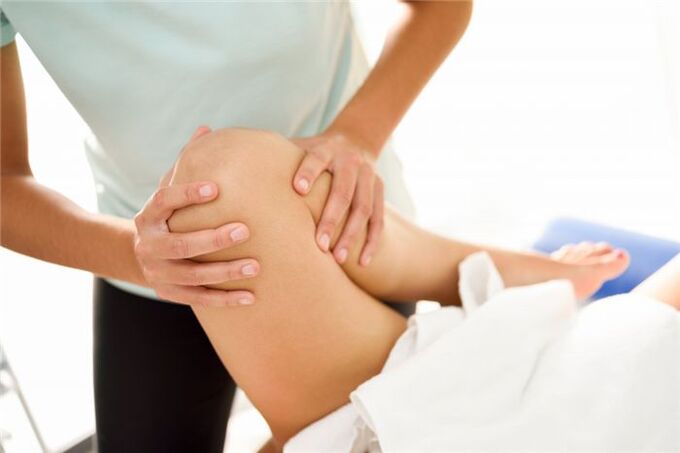
Symptoms of knee osteoarthritis
Gradually increasing pain in the knee joint. At first, the pain is only noticeable with movement - for example, when straightening or bending the leg, there is a feeling of "unfortunately stepping on the foot". In the early stages, the pain may be intermittent or so mild that it is considered discomfort. The pain then increases after exertion or prolonged lying in the same position. The skin also becomes painful - it reacts sensitively to any touch, including. and clothes.
There are three specific types of pain associated with knee deformity:
- start (lasts 15-30 minutes after the joint comes out of a long resting state);
- mechanical (feeling during physical activity and disappearing after rest);
- blockade (pins and needles sensation in the knee).
Symptoms of knee deformity, as a rule, develop slowly due to the fact that the disease is not characterized by rapid progression. This is the insidiousness of joint disease - gradually getting used to the discomfort of the disease, the patient "gets used to" the pain, not noticing the worsening, and delaying the visit to the doctor.
Knowing the main symptoms of knee osteoarthritis will help identify the disease in time
Treatment of knee deformity.
Treatment of joint deformities of the knee joint includes the complex use of drugs, a dosage for the joint, physiotherapeutic procedures and the use of orthopedic devices.
During treatment, it is extremely important to alternate loading and unloading, avoiding static loads on the knee joint. Orthopedic insoles, specialized shoes, canes, crutches, walkers, work and rest chairs also help slow the disease. Particularly effective are orthotics with a variable stiffener, which model the physiological axis of the leg and compensate for the deformity.
In the early stages of knee deformity, the goals of treatment are to restore damaged joint apparatus and ligaments, relieve pain, and increase voluntary range of motion. In later times - in the alleviation of the patient's condition. For this case, sanation arthroscopy (washing with antiseptics) is done when a piece of bone-forming substance is broken off, orthopedic surgery (correction of curvature), arthroscopy (replacement) of the joint.
In addition to orthopedists, physiotherapists and chiropractors, exercise and massage therapists, and surgeons will tell you how to treat knee deformities.
Treatment of joint deformities of the joints is a complex and lengthy process that requires an integrated approach.
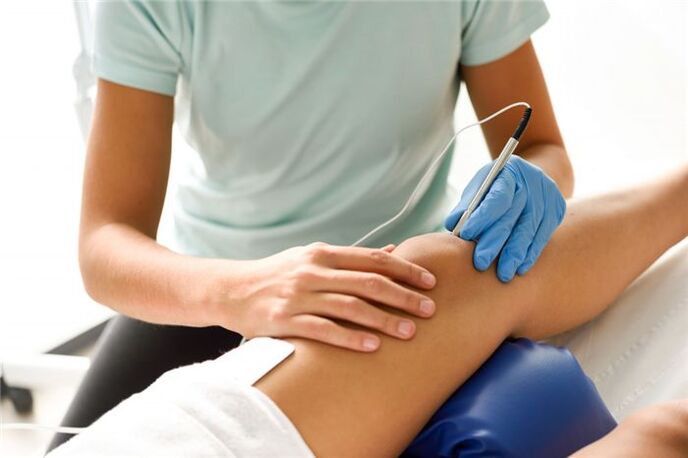
Physical therapy
Among other physical therapy methods for treating knee deformity, the following are used:
- laser and magnetic therapy;
- microwave therapy;
- shock wave therapy;
- amplipulse;
- therapeutic ultrasound;
- Electrophoresis with analgin, novocaine, chymotrypsin, etc. v . . . ;
- phonophoresis with glucocorticoids;
- paraffin and ozocerite application;
- cryotherapy;
- Acupuncture;
- joint traction and kinesitherapy;
- balneotherapy.
Knee osteoarthritis massage
Lymphatic drainage massage and therapy for the treatment of knee deformities, as well as manual therapy, are performed by a specialist after the joint inflammation has subsided. For self-massage at home, it is recommended to stroke and massage, as well as movements aimed at stretching muscles and ligaments, a deep warm-up (done last, after the warming action). Self-massage is suitable for topical irritants and essential oils. Remember that with joint deformity of the knee joint, massage is performed on both joints, even if only one of them is affected.
Exercises to cure knee deformity
Exercise therapy (exercise therapy) for osteoarthritis of the knee is done in a sitting or lying position, water aerobics is also effective. Individual set of exercises to treat knee osteoarthritis compiled by instructors. Below we provide a short warm-up aimed at strengthening the calf muscles.
- Sit on the floor, legs straight, hands behind your back. Bend and not flex your toes.
- Starting position is the same, slowly bend the legs, the end of the movement rests the toes on the floor. Repeat with the back foot of the other foot.
- Continue in the same starting position, lifting your legs out in front of you, toes facing you.
- Without changing the starting position, we pull our hands towards the toes of the straight leg.
- Sit on the floor, hug your bent knee, and try to raise your other leg above the floor.
- Sit on the floor, feet shoulder width apart. Rotate your legs so that your toes move 180 degrees.
- Sit on the floor, legs bent. Roll your feet from heel to toe, feeling the work on the back of your thighs.
Excellent! Perform knee osteoarthritis exercises at least 3 - 6 times / day.
Medicines to treat knee deformity
Medicines to treat knee deformities help you quickly stop acute pain, reduce inflammation, and improve nutrition for joints. Therefore, the drug is used at all stages of the disease and helps restore mobility to the knee joint.
Chondroprotectors
Chondroprotectors in the form of tablets, capsules, packs and injections are used to regenerate and maintain synovial cartilage.
Anti-inflammatory
Steroid and non-steroidal anti-inflammatory drugs are used to treat joint deformities of the knee joint. They are prescribed in the form of tablets, injections, sachets, creams, ointments and other products for external and internal use.
Anti-inflammatory drugs can be used along with anesthetics, which are injected into the joint cavity to block.
Antispasmodic drugs
Removal of the spasm is necessary for the patient to return to normal activities and to provide normal nutrients to the tissues.
Angioprotectors
For joint deformities of the knee joint, preparations based on horse chestnut and others are used.
Warming agent
Among the warming agents, it is worth noting preparations based on natural ingredients: snake and bee venom, hot peppers, mustard.
All these drugs help improve blood supply to tissues and relieve pain.
Nutrition treatment of knee deformity
A healthy diet for the treatment of osteoarthritis of the knee includes foods that are low in trans fats and "fast" carbohydrates. Prefer lean meat and fish, seafood and vegetables, steamed, in foil or stewed under the lid. Also helpful are fruits, berries and antioxidant-rich beverages - wild plants, blueberries, reishi, cranberries, green tea and high-quality coffee. You can also eat whole grains and legumes.
But potatoes, white bread, sweets, convenience foods, fast food and alcohol should be excluded.
If you are overweight with knee deformity, consider low-carbohydrate diet options.



























